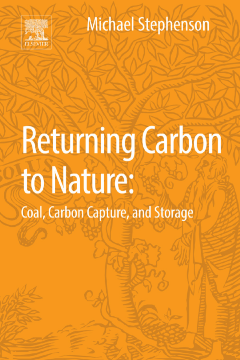
Additional Information
Book Details
Abstract
Carbon capture and storage is one of the main carbon emissions policy issues globally, yet you may know little about it if you’re outside the academic community. As the global push to address the impact that carbon emissions has on global warming continues, awareness and knowledge of viable solutions must be communicated in layperson terms. Returning Coal and Carbon To Nature breaks across traditional barriers among history, geology, biology and climate change to address the topic from a multidisciplinary, Earth System Science approach. If you’re a policymakeror someone who influences policy, this book will explain carbon capture and storage—a relatively new concept—in easy-to-understand terms. Clearly presented charts, tables and diagrams explain critical concepts, and a range of full-color photographs will help you visualize the carbon capture and storage process and its principles.
- Discusses carbon capture and storage in terms easily accessible to a range of stakeholders, including policymakers worldwide and geoscientists who influence policy.
- The first cross-disciplinary look at the history, geology and biology of coal, and presents carbon capture and storage in the context of Earth System Science.
- Authored by one of the world’s foremost carbon capture and storage experts who has more than 30 years of field research experience.
… describes the importance of coal for generating electricity, the need to reduce carbon emissions, and the processes for capturing, transporting, injecting, and storing carbon dioxide in geological formations… illustrates the significance of electricity in people's lives and in economic development by focusing on India, China, and South Africa,… Summing Up: Recommended.--CHOICE, July 1, 2014
"..breaks across traditional barriers among history, geology, biology and climate change to address the topic from a multidisciplinary, Earth System Science approach. If you’re a policymaker or someone who influences policy, this book will explain carbon capture and storage-a relatively new concept- in easy-to-understand terms."--GeoQ, March 2014 "Stephenson argues for carbon capture and storage (CCS) as an important tool in stabilizing the environment while reducing CO2 emissions.…Though the book makes use of some technical symbols and makes quantitative arguments using available data, the conceptual basis of climate change and CCS technology is explained in conversational prose that opens the book to nontechnical readers."--ProtoView.com, January 2014
This from Amazon: http://www.amazon.co.uk/Returning-Carbon-Nature-Capture-Storage/dp/0124076718
5.0 out of 5 stars Excellent review of an important topic 3 Jan 2014 By Dr. P. Styles Format:Paperback|Verified Purchase Carbon Capture and Storage (CCS) has to be part of our strategy to deal with ever increasing amounts of atmospheric carbon dioxide in a world where use of fossil fuels is likely to continue for the foreseeable future. However, despite huge initial enthusiasm has not yet been able to obtain much purchase globally. Mike Stephenson explains very clearly why it is essential, how it might be done technically and what governments must do to start implementing this crucial weapon in the struggle to contain global climate change.
and this from the Geoscientist: http://www.geolsoc.org.uk/Geoscientist/June-2014/Books-and-Arts
Returning Carbon to Nature: Coal, Carbon Capture and Storage In this slim, dense, yet highly readable volume, BGS Director of Science and Technology Mike Stephenson sets out the whole landscape of coal use, climate change and CCS with great clarity. The account benefits greatly from the ‘long view’ which geology affords.
The first chapter, ‘Of Hockey Sticks and Coal’, sets out the central dilemma: reconciling the increasingly pressing need to address climate change with the ongoing centrality of coal to economic development in the world’s most populous countries. It is no good wringing our hands and wishing it were otherwise: "A CO2 emissions strategy for these countries therefore relies on an abatement method that is consistent with long-term coal use, or coal use as a bridge to renewables. Such an abatement method could be carbon capture and storage".
The second chapter takes a brief pause from present-day controversies to offer an absorbing update on the scientific understanding of coal formation and its consequences for palaeoclimate. Stephenson highlights how the swift-growing nature of the main Carboniferous swamp plants, coupled with rapid subsidence and burial of the peats, led to a “negative greenhouse effect attested by δ13C signatures in sedimentary organic matter.
The account then returns to the present day, with overviews of carbon capture technology and its scope for deployment in distinct industrial clusters in the UK and elsewhere (Chapter 3), and the practicalities of creating deep underground carbon stores (Chapter 4). In addressing the key question "Is there enough storage space, then?" Stephenson examines CCS prospects in the crux countries of India and China.
Clearly those prospects need much more research, but by this account there are certainly grounds for cautious optimism. The fifth chapter ("Will it leak?") addresses the bête noir of the new generation of geologically-challenged opponents of all subsurface engineering, while the final chapter ("Accounting for carbon") considers the economics and politics of making CCS happen. Again, the discussion is honest, lucid and engaging.
The book is beautifully illustrated in colour throughout, though Elsevier could have made put a little more effort into proof-reading, and putting the title on the spine might have been useful. But these quibbles are minor: the book is a tour de force and I recommend it without hesitation.
